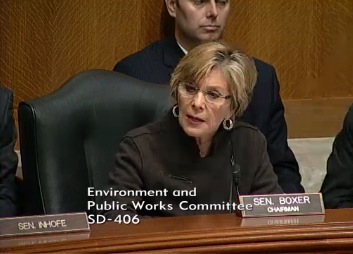The Senate is scheduled to begin debating their transportation bill (MAP-21) today. We’re going to be keeping a close eye on a handful of amendments that could improve or make damaging changes to the bill as they’re offered, debated and voted on. Save or bookmark this page to keep tabs on these amendments that we’re tracking.
(This is in no way an exhaustive list of all Senate amendments or even all of the relevant ones. But it’s a short list of significant ones we’re keeping our eyes on.)
Last updated: 3/1/12 10:40 a.m.
| Senator and # | Description | Outcome or Notes |
|---|---|---|
| Cardin-Cochran 1549 | Local Access and Control This provides local communities and metropolitan regions with access to the "Additional Activities" pot of funding through a competitive grant program — funding that they can use for main street revitalizations, boulevard conversions, new bike facilities, or safety improvements to make streets safer for everyone. Large metro areas will receive some funds directly. Read our explainer on the amendment here | Formally adopted into Senate manager's amendment package on 3/1/12. Amendment text (pdf) |
| Franken-Blunt 1543 | Bridge Repair This would help provide adequate funding and flexibility to states to repair and rehabilitate the 180,000 federal-aid bridges that are not on the National Highway System (NHS). These bridges would become eligible for a 40% share of the main highway program funds (National Highway Performance Program) that aren't currently required for repairing the National Highway System. | Formally adopted into Senate manager's amendment package on 3/1/12. One-pager on federal-aid bridges (pdf) Amendment text (pdf) |
| Landrieu 1630 | Protecting MPOs from State Penalties This ensures that metropolitan areas (MPOs) aren't left on the hook for financial penalties if states do not meet their state requirements for fixing roads and bridges or develop a state highway safety plan. | Formally adopted into Senate manager's amendment package on 3/1/12. Amendment text (pdf) |
| Blunt-Casey 1540 | Repairing Non-Federal Bridges Restores the former small portion of money dedicated to repairing other federal-aid bridges that aren't on the federal highway system. MAP-21 currently only requires states to spend Transportation Mobility Program (TMP) money on these bridges if conditions worsen. This would restore the small amount of money dedicated to repairing these bridges. (Off-system bridges are those not located on a federal-aid highway.) | Reached floor as part of agreement on amendments. Check this page for updates on current amendments. |
| Bennet-Warner 1705 | Encouraging Development Near Transit This would provide local governments and others federal credit instruments – similar to TIFIA loans that would be paid back – for public infrastructure near transit stations. to help encourage private sector development. It will prioritize applicants that do scenario planning. | NOT accepted in agreement to debate as part of bill. Click for details and a new list of amendments that were accepted for debate here. Amendment text (pdf) One-page summary of amendment (pdf) |
| Shaheen-Murkowski (and others) 1679 | Protecting Small Metro Areas This removes the provision to disband metro area planning organizations in areas under 200,000 people. It also allows MPOs serving areas smaller than 100,000 to voluntarily disband. | NOT accepted in agreement to debate as part of bill. Click for details and a new list of amendments that were accepted for debate here. |
| Cardin 1542 | Equal Opportunity (Jobs) This requires the Secretary to undertake an assessment of equal opportunity and nondiscrimination on federal-aid transportation projects, report on that every four years and make data publicly available | NOT accepted in agreement to debate as part of bill. Click for details and a new list of amendments that were accepted for debate here. |
| Cardin 1552 | Stormwater Pilot Program Directs DOT to establish a pilot program to reduce stormwater runoff from federal-aid highways and authorizes funding to appropriated. The pilot program must be created for 3 states or regions. | NOT accepted in agreement to debate as part of bill. Click for details and a new list of amendments that were accepted for debate here. |
| Akaka 1720 | Rural Transit Improvement Currently, all human services transit providers are required to coordinate with each other. This amendment would require all of the rural transit providers — including those above already required — to communicate and coordinate when planning their transit service. This is more important in spread out rural areas with many small providers covering a wide, spread-out area — resulting in more effective service and better use of taxpayer funds. | NOT accepted in agreement to debate as part of bill. Click for details and a new list of amendments that were accepted for debate here. One-pager on rural transit (pdf) Amendment text (pdf) |
| Carper-Lieberman 1665 | Protecting Air Quality This reinserts the requirement that states need to include congestion mitigation and air quality performance targets in state transportation planning. | NOT accepted in agreement to debate as part of bill. Click for details and a new list of amendments that were accepted for debate here. Amendment text (pdf) |
| Begich 1724 | Increasing MPO suballocation Restores the suballocation percentage for metro areas to levels in current law, resulting in more money allocated directly to metro areas under MAP-21. | NOT accepted in agreement to debate as part of bill. Click for details and a new list of amendments that were accepted for debate here. |
| Gillibrand 1648 | Workforce Development Authorizes new construction careers demonstration program. | NOT accepted in agreement to debate as part of bill. Click for details and a new list of amendments that were accepted for debate here. |




